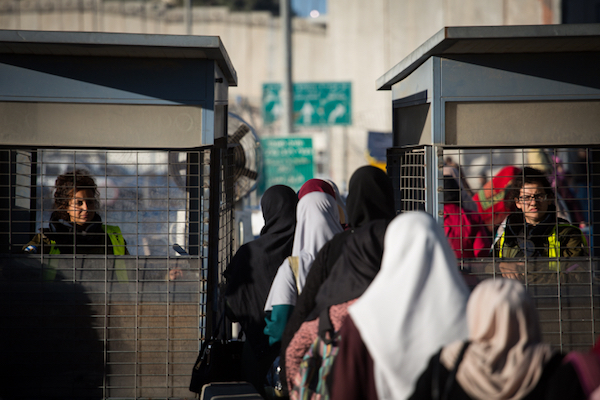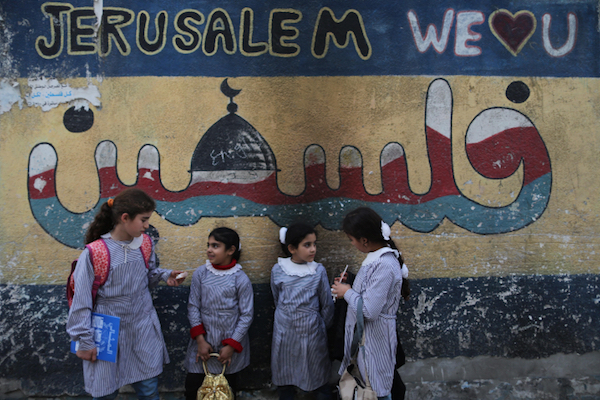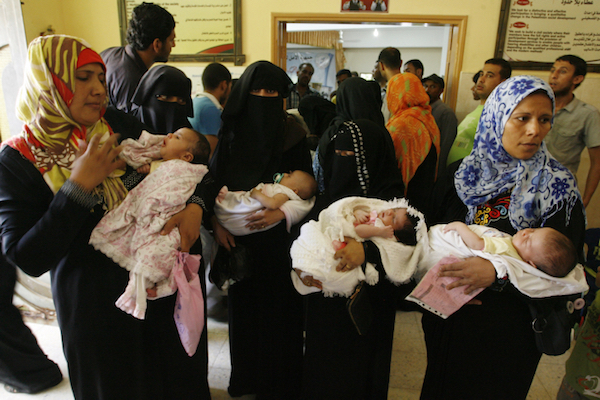For years, the United States was the largest aid donor to Palestinians. With funding to health, education and sanitation programs brought to a sudden halt, it’s women and girls who are hit the hardest.

When Nawal’s husband had to stop working two years ago due to severe stomach pains, she became the family’s primary provider. Nawal, who asked to use only her first name, lives with her seven children in Dheisheh refugee camp, near Bethlehem. Nawal used to be eligible for stipends from UNRWA that would help her cover the family’s medical costs, but she was recently told this assistance is no longer available.
Zahya Al Mubasher is a widow fighting cancer in Gaza. At 61, she is still the provider for 17 of her children, grandchildren and siblings. She makes a living by growing tomatoes in a backyard greenhouse that was funded by USAID, a U.S government agency responsible for administering civilian foreign aid and development assistance.
Nawal and Zahya are only two of thousands of Palestinian women who are directly affected by the Trump administration’s decision to dry up aid funding to Palestinians. The administration most recently shut down USAID’s mission in the West Bank and Gaza, while cutting more than half a billion dollars in funding to Palestinian projects in 2018. Critics say it is just the latest attempt to blackmail the Palestinian Authority into a peace agreement with Israel.
When society or institutions start to break down because of lack of investment, women are even further burdened by the domestic responsibilities they are traditionally associated with, says Susan Markham, USAID’s former senior coordinator for gender equality and women’s empowerment. Managing time between professional responsibilities and “housework,” she adds, becomes an even greater challenge. “It’s something that is not measured oftentimes, but has a real impact on everyday women’s lives,” she says.
The effects of such a break down on women are twofold: gender-focused programs funded by the U.S. have now been scrapped, reducing the number of initiatives that focus exclusively on promoting women’s rights and opportunities, while larger infrastructure-related projects — such as in health and sanitation — remain unfinished. This can have a detrimental impact on the roles of women and girls in society.

Hundreds of thousands of dollars in U.S. aid went toward Palestinian women’s rights advocacy programs over the past several years. Among the aid recipients is Kayan, a feminist organization protecting the rights and advancing the status of Palestinian women in Israel, which was awarded a grant by the U.S. government for a project that strives to end sexual harassment in the workplace. In the West Bank and Gaza, the American-funded “Women’s Courts” project aimed to reduce gender-based violence in Palestinian communities through legislative reforms and policy changes.
Palestine is the only country in the Middle East and North Africa that has acceded to the UN Convention on the Elimination of All Forms of Discrimination against Women (CEDAW) without reservations or declarations. Palestinian women are among the most educated in the region, and while more women are entering the workforce today than 10 years ago, the rates are still lower compared to regional averages, according to a 2017 World Bank report.
“USAID really focused on helping [Palestinian] women gain economic empowerment,” says Markham. It involved programs that put girls through high school, funded internships and mentorships, and helped women start their own companies, creating a positive cycle where women “were being valued by the community as a business owner or a worker able to bring money home to the family.” These changes, she says, helped shift gender attitudes in Palestinian society.
Over the past two decades, U.S. funds have helped more than 200,000 female students in the West Bank and Gaza gain access to a better education through investments in school renovations and training. These initiatives have now come to a sudden halt.
One of the most severe cases is a school in the Bethlehem area that only goes up to 10th grade, says Sean Carroll, the head of Anera, one of the largest non-governmental organizations providing humanitarian assistance to Palestinians. Anera had been working on rehabilitating and expanding the school to offer students a secondary education. “If you wanted to continue your studies, you had to go 30 miles away. A lot of the kids didn’t, particularly the girls, so effectively girls’ education in that town was stopping at 10th grade,” he explains.
Keeping girls in school is also one of the most effective ways to avoid child marriage, still a significant problem in Palestine, according to a joint statement by the Women’s Centre for Legal Aid and Counselling (WCLAC) and Human Rights Watch from last July. Based on data released by the Palestinian Central Bureau of Statistics, in 2016, child marriage reached 20.5 percent among women and one percent among men of the total married population in Palestine.

A significant factor discouraging girls from attending school is lack of access to appropriate sanitation facilities during menstruation, due to lack of access to water and adequate hygiene. Abandoning investments in water infrastructures, which connect homes to clean water and sewage networks, is therefore likely to affect women and girls unfavorably.
Furthermore, water shortages add pressure on women, who are often tasked with household chores, including cooking and cleaning, as well as caring for children who contract waterborne diseases. In areas that aren’t connected to water networks, women and girls are usually responsible for finding and collecting water for their families, which can prevent them from attending school or engaging in paid work, according to EWASH, a group of over 30 organizations working on water, sanitation, and hygiene issues in the occupied territories.
“The biggest amount of our USAID project funding over the past 10 years has been in water and wash,” says Carroll, “and with the cuts right now, we know 57,000 Palestinians will not get access to safe water [through a project] that was planned and would have been implemented by the end of the year.”
Israel’s rule over Palestinians restricts the entry of goods to the occupied territories, including medicine and medical equipment. As a result, life-saving health services, such as cancer treatment and neonatal intensive care, are not available in the West Bank and Gaza. Many Palestinian patients travel to East Jerusalem to receive care at one of six hospitals that comprise the East Jerusalem Hospital Network. Last September, the Trump administration pulled $25 million it had planned to give the Network.
According to Bassem Abu Libdeh, the director of Al Makassed Hospital, U.S. funding used to cover 40 percent of costs for the six hospitals. Coupled with last September’s slash in aid to UNRWA, which amounted to a 30-percent budget cut to the United Nations agency tasked with providing services to millions of Palestinian refugees in the Middle East, many Palestinians can no longer afford the care they need. For women, this means limited access to breast cancer treatment or care for high-risk pregnancies available predominantly at these East Jerusalem hospitals.
These funding shortages have further undermined the operation of mobile clinics, operated by a group of Palestinian and international NGOs called the Health Cluster, which provide health services to more than 220,000 Palestinians in the West Bank. According to the Office for the Coordination of Humanitarian Affairs in the occupied territories, “the most vulnerable in these communities include women during pregnancy and childbirth; sick children and infants; the elderly; and the chronically ill or disabled.” This not only has a direct effect on women’s health programs, but also adds pressure on women who usually act as caretakers in the family, such as Nawal.
Israel’s occupation severely limits the Palestinian economy. Restrictions on the movement of goods and people, land grabs, and the blockade on Gaza, among other things, stifle the success of economic policies set by the PA. As a result, international donors play a prominent role in implementing reforms and delivering services in Palestine, according to the World Bank. Both government entities and civil society organizations are heavily reliant on foreign aid to operate.
“The Palestinian national economy cannot sustain itself as a result of the occupation and its policies,” says Dr. Sahar Qawasmi, who was elected as a member of the Palestinian Legislative Council in 2006 and serves on the board of WCLAC. “When a woman is subjected to violence, is denied economic opportunities and political agency, it significantly affects future generations.”

